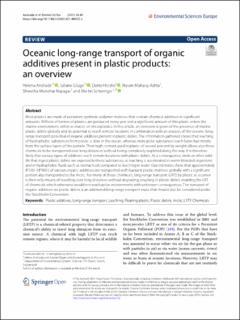| dc.contributor.author | Andrade, Helena | |
| dc.contributor.author | Glüge, Juliane | |
| dc.contributor.author | Herzke, Dorte | |
| dc.contributor.author | Ashta, Narain Maharaj | |
| dc.contributor.author | Nayagar, Shwetha Manohar | |
| dc.contributor.author | Scheringer, Martin | |
| dc.date.accessioned | 2021-08-11T05:43:13Z | |
| dc.date.available | 2021-08-11T05:43:13Z | |
| dc.date.created | 2021-08-05T14:00:05Z | |
| dc.date.issued | 2021 | |
| dc.identifier.citation | Environmental Sciences Europe. 2021, 33, 85. | en_US |
| dc.identifier.issn | 2190-4715 | |
| dc.identifier.uri | https://hdl.handle.net/11250/2767248 | |
| dc.description.abstract | Most plastics are made of persistent synthetic polymer matrices that contain chemical additives in significant amounts. Millions of tonnes of plastics are produced every year and a significant amount of this plastic enters the marine environment, either as macro- or microplastics. In this article, an overview is given of the presence of marine plastic debris globally and its potential to reach remote locations in combination with an analysis of the oceanic long-range transport potential of organic additives present in plastic debris. The information gathered shows that leaching of hydrophobic substances from plastic is slow in the ocean, whereas more polar substances leach faster but mostly from the surface layers of the particle. Their high content used in plastic of several percent by weight allows also these chemicals to be transported over long distances without being completely depleted along the way. It is therefore likely that various types of additives reach remote locations with plastic debris. As a consequence, birds or other wildlife that ingest plastic debris are exposed to these substances, as leaching is accelerated in warm-blooded organisms and in hydrophobic fluids such as stomach oil, compared to leaching in water. Our estimates show that approximately 8′100–18′900 t of various organic additives are transported with buoyant plastic matrices globally with a significant portion also transported to the Arctic. For many of these chemicals, long-range transport (LRT) by plastic as a carrier is their only means of travelling over long distances without degrading, resulting in plastic debris enabling the LRT of chemicals which otherwise would not reach polar environments with unknown consequences. The transport of organic additives via plastic debris is an additional long-range transport route that should also be considered under the Stockholm Convention. | en_US |
| dc.language.iso | eng | en_US |
| dc.rights | Navngivelse 4.0 Internasjonal | * |
| dc.rights.uri | http://creativecommons.org/licenses/by/4.0/deed.no | * |
| dc.title | Oceanic long-range transport of organic additives present in plastic products: an overview | en_US |
| dc.type | Peer reviewed | en_US |
| dc.type | Journal article | en_US |
| dc.description.version | publishedVersion | en_US |
| dc.rights.holder | © The Author(s) 2021. | en_US |
| dc.source.pagenumber | 14 | en_US |
| dc.source.volume | 33 | en_US |
| dc.source.journal | Environmental Sciences Europe | en_US |
| dc.identifier.doi | 10.1186/s12302-021-00522-x | |
| dc.identifier.cristin | 1924150 | |
| dc.relation.project | Norges forskningsråd: 275172 | en_US |
| dc.relation.project | NILU - Norsk institutt for luftforskning: 117031 | en_US |
| dc.source.articlenumber | 85 | en_US |
| cristin.ispublished | true | |
| cristin.fulltext | original | |
| cristin.qualitycode | 1 | |

